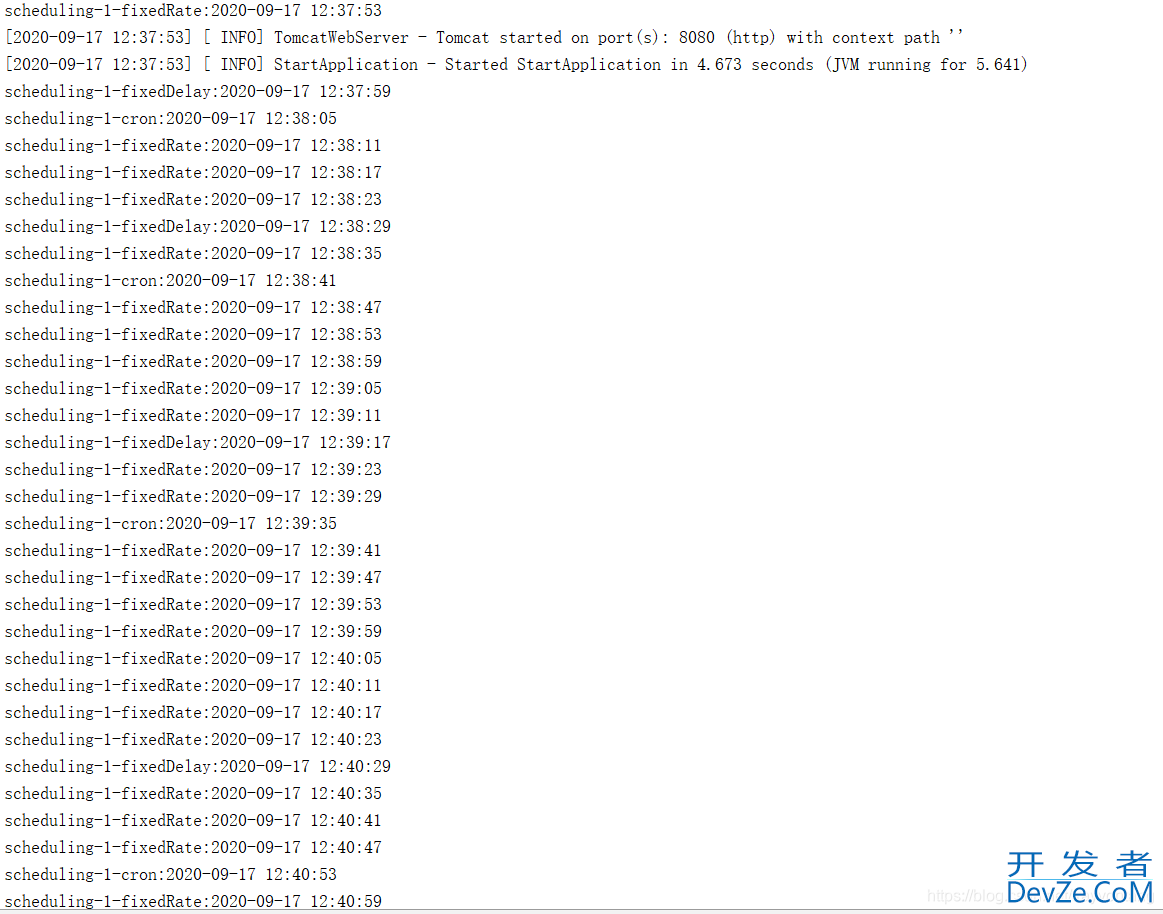目录
- 简介
- 注意事项
- @Schedule默认线程池大小
- 固定延迟与固定速率
- SpringBoot @Schedule原理
- ScheduledAnnotationBeanPostProcessor
- DestructionAwareBeanPostProcessor封装任务
- ApplicationListener执行任务
- 总结
简介
之前使用@Schedjsule一直没有遇到什么问题,那种拿来就用的感觉还挺好,最近使用@Schedule遇到一点问题,才仔细的研究了一下@Schedule的一些细节和原理问题。
这篇文章就将分享一下,使用@Schedule一些可能被忽略的问题。
注意事项
@Schedule默认线程池大小
我相信@Schedule默认线程池大小的问题肯定是被很多拿来就用的朋友忽略的问题,默认情况下@Schedule使用线程池的大小为1。
一般情况下没有什么问题,但是如果有多个定时任务,每个定时任务执行时间可能不短的情况下,那么有的定时任务可能一直没有机会执行。
有兴趣的朋友,可以试一下:
@Component
public class BrigeTask {
private static final DateTimeFormatter FORMATTER = DateTimeFormatter.ofPattern("yyyy-MM-dd HH:mm:ss");
@Scheduled(cron = "*/5 * * * * ?")
private void cron() throws InterruptedException {
System.out.println(Thread.currentThread().getName() + "-cron:" + LocalDateTime.now().format(FORMATTER));
TimeUnit.SECONDS.sleep(6);
}
@Scheduled(fixedDelay = 5000)
private void fixedDelay() throws InterruptedException {
System.out.println(Thread.currentThread().getName() + "-fixedDelay:" + LocalDateTime.now().format(FORMATTER));
python TimeUnit.SECONDS.sleep(6);
}
@Scheduled(fixedRate = 5000)
private void fixedRate() throws InterruptedException {
System.out.println(Thread.currentThread().getName() + "-fixedRate:" + LocalDateTime.now().format(FORMATTER));
TimeUnit.SECONDS.sleep(6);
}
}
上面的任务中,fixedDelay与cron,可能很久都不会被执行。

要解决上面的问题,可以把执行任务的线程池设置大一点,怎样设置通过javascript实现SchedulingConfigurer接口,在configureTasks方法中配置,这种方式参见后面的代码,这里可以直接注入一个TaskScheduler来解决问题。
@Bean
public TaskScheduler taskScheduler() {
ThreadPoolTaskScheduler taskScheduler = new ThreadPoolTaskScheduler();
taskScheduler.setPoolSize(5);
return taskScheduler;
}
当然也可以使用ScheduledExecutorService:
@Bean
public ScheduledExecutorService scheduledExecutorService() {
return Executors.newScheduledThreadPool(10);
}
为啥这样有效,请参考后面@Schedule原理。
固定延迟与固定速率
@Schedule的三种方式cron、fixedDelay、fixedRate不管线程够不够都会阻塞到上一次执行完成,才会执行下一次。
如果任务方法执行时间非常短,上面三种方式其实基本没有太多的区别。
如果,任务方法执行时间比较长,大于了设置的执行周期,那么就有很大的区别。例如,假设执行任务的线程足够,执行周期是5s,任务方法会执行6s。
- cron的执行方式是,任务方法执行完,遇到下一次匹配的时间再次执行,基本就会10s执行一次,因为执行任务方法的时间区间会错过一次匹配。
- fixedDelay的执行方式是,方法执行了6s,然后会再等5s再执行下一次,在上面的条件下,基本就是每11s执行一次。
- fixedRate的执行方式就变成了每隔6s执行一次,因为按固定区间执行它没5s就应该执行一次,但是任务方法执行了6s,没办法,只好6s执行一次。
上面的结论都可以通过,最上面的示例验证,有兴趣的朋友可以调整一下休眠时间测试一下。
SpringBoot @Schedule原理
在SpringBoot中,我们使用@EnableScheduling来启用@Schedule。
@Target(ElementType.TYPE)
@Retention(RetentionPolicy.RUNTIME)
@Import(SchedulingConfiguration.class)
@Documented
public @interface EnableScheduling {
}
EnableSchedEBGyOjRuling注解没什么特殊,需要注意import了SchedulingConfiguration。
SchedulingConfiguration一看名字就知道是一个配置类,肯定是为了添加相应的依赖类。
@Configuration
@Role(BeanDefinition.ROLE_INFRASTRUCTURE)
public class SchedulingConfiguration {
@Bean(name = TaskManagementConfigUtils.SCHEDULED_ANNOTATION_PROCESSOR_BEAN_NAME)
@Role(BeanDefinition.ROLE_INFRASTRUCTURE)
public ScheduledAnnotationBeanPostProcessor scheduledAnnotationProcessor() {
return new ScheduledAnnotationBeanPostProcessor();
}
}
我们可以看到在SchedulingConfiguration创建了一个ScheduledAnnotationBeanPostProcessor。
看样子SpringBoot定时任务的核心就是ScheduledAnnotationBeanPostProcessor类了,下面我们来看一看ScheduledAnnotationBeanPostProcessor类。
ScheduledAnnotationBeanPostProcessor
public class ScheduledAnnotationBeanPostProcessor
implements ScheduledTaskHolder, MergedBeanDefinitionPostProcessor, DestructionAwareBeanPostProcessor,
Ordered, EmbeddedValueResolverAware, BeanNameAware, BeanFactoryAware, ApplicationContextAware,
SmartInitializingSingleton, ApplicationListener<ContextRefreshedEvent>, DisposableBean {
}
ScheduledAnnotationBeanPostProcessor实现了很多接口,这里重点关注2个,ApplicationListener和DestructionAwareBeanPostProcessor。
DestructionAwareBeanPostProcessor封装任务
DestructionAwareBeanPostProcessor继承了BeanPostProcessor。
BeanPostProcessor相信大家已经非常熟悉了,就是在Bean创建执行setter之后,在自定义的afterPropertiesSet和init-method前后提供拦截点,大致执行的先后顺序是:
Bean实例化 -> setter -> BeanPostProcessor#postProcessBeforeInitialization -> -> InitializingBean#afterPropertiesSet -> init-method -> BeanPostProcessor#postProcessAfterInitialization
我们看一下ScheduledAnnotationBeanPostProcessor的postProcessAfterInitialization方法:
@Override
public Object postProcessAfterInitialization(Object bean, String beanName) {
if (bean instanceof AopInfrastructureBean || bean instanceof TaskScheduler ||
bean instanceof ScheduledExecutorService) {
// Ignore AOP infrastructure such as scoped proxies.
return bean;
}
Class<?> targetClass = AopProxyUtils.ultimateTargetClass(bean);
if (!this.nonAnnotatedClasses.contains(targetClass) &&
AnnotationUtils.isCandidateClass(targetClass, Arrays.asList(Scheduled.class, Schedules.class))) {
Map<Method, Set<Scheduled>> annotatedMethods = MethodIntrospector.selectMethods(targetClass,
(MethodIntrospector.MetadataLookup<Set<Scheduled>>) method -> {
Set<Scheduled> scheduledMethods = AnnotatedElementUtils.getMergedRepeatableAnnotations(
method, Scheduled.class, Schedules.class);
return (!scheduledMethods.isEmpty() ? scheduledMethods : null);
});
if (annotatedMethods.isEmpty()) {
this.nonAnnotatedClasses.add(targetClass);
if (logger.isTraceEnabled()) {
logger.trace("No @Scheduled annotations found on bean class: " + targetClass);
}
}
else {
// Non-empty set of methods
annotatedMethods.forEach((method, scheduledMethods) ->
scheduledMethods.forEach(scheduled -> processScheduled(scheduled, method, bean)));
if (logger.isTraceEnabled()) {
logger.trace(annotatedMethods.size() + " @Scheduled methods processed on bean '" + beanName +
"': " + annotatedMethods);
}
}
}
return bean;
}
简单说一下流程:
找到所有的Schedule方法,把它封装为ScheduledMethodRunnabpythonle类(ScheduledMethodRunnable类实现了Runnable接口),并把其做为一个任务注册到ScheduledTaskRegistrar中。
如果对具体的逻辑感兴趣,可以从postProcessAfterInitialization方法顺着processScheduled方法一次debug。
ApplicationListener执行任务
前面我们介绍通过BeanPostProcessor解析出了所有的任务,接下来要做的事情就是提交任务了。
@Override
public void onApplicationEvent(ContextRefreshedEvent event) {
if (event.getApplicationContext() == this.applicationContext) {
// Running in an ApplicationContext -> register tasks this late...
// giving other ContextRefreshedEvent listeners a chance to perform
// their work at the same time (e.g. Spring BATch's job registration).
finishRegistration();
}
}
ScheduledAnnotationBeanPostProcessor监听的事件是ContextRefreshedEvent,就是在容器初始化,或者刷新的时候被调用。
监听到ContextRefreshedEvent事件之后,值调用了finishRegistration方法,这个方法的基本流程如下:
- 1.找到容器中的SchedulingConfigurer,并调用它的configureTasks,SchedulingConfigurer的作用主要就是配置ScheduledTaskRegistrar类,例如线程池等参数,例如:
import org.springframework.context.annotation.Configuration;
import org.springframework.scheduling.annotation.SchedulingConfigurer;
import org.springframework.scheduling.config.ScheduledTaskRegistrar;
import Java.util.concurrent.Executors;
@Configuration
public class MyScheduleConfig implements SchedulingConfigurer {
@Override
public void configureTasks(ScheduledTaskRegistrar taskRegistrar) {
taskRegistrar.setScheduler(Executors.newScheduledThreadPool(10));
}
}
- 2.调用ScheduledTaskRegistrar的afterPropertiesSet方法执行任务,如果对具体的逻辑感兴趣,可以阅读ScheduledTaskRegistrar的scheduleTasks方法。
关于为啥直接在容器中注入一个TaskScheduler、ScheduledExecutorService也可以有效,也可以在finishRegistration方法中找到答案。
总结
以上为个人经验,希望能给大家一个参考,也希望大家多多支持编程客栈(www.devze.com)。









 加载中,请稍侯......
加载中,请稍侯......
精彩评论